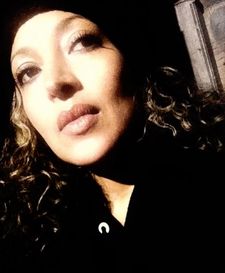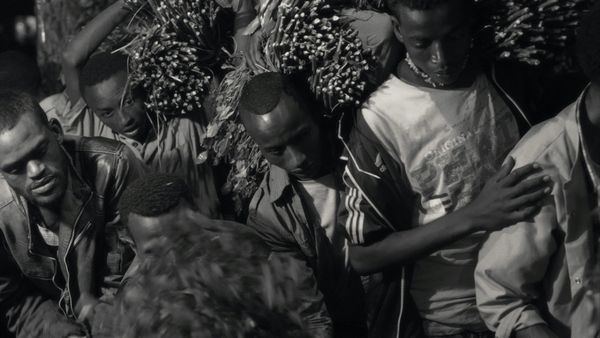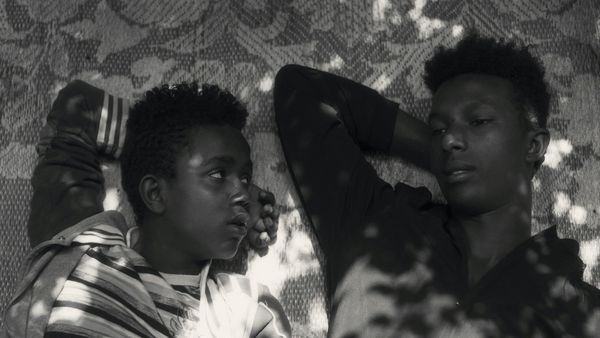The filmmaker was almost 16 when she and her family left their home in the city of Harrar, in the east of the country, fleeing the communist regime in the country for her mother’s homeland of Mexico in a hurry. “Oh my God,” Beshir says, “It was from one day to the next. I remember talking to the school and the director, she says, ‘Okay, your mama's here’. And I thought, ‘Oh,my God, what did I do now?’ So I go to the to the office, and my mom is like, ‘You know, it's time to say goodbye to friends because we are going to have to leave tomorrow’. I'm like, ‘What?’ Like that. No questions. Nothing, no information. Talk about uprooting, that's how sudden these things work for a lot of families. We were the lucky ones, one of the lucky ones.” That said she says that moving Mexico was “a shock to the system in every possible way”.
 |
| Jessica Beshir: 'Other than, of course personal healing, this film has been a personal school of making films' |
The project took shape across a decade, with Beshir shooting for “two weeks, three weeks, sometimes four weeks at a time”. She adds: “The time that I was in Brooklyn was the time for me to really envision and kind of interpret all of these feelings, all of these the statuses that people were experiencing and for me to kind of think, how could I visually expand on this? How can I visually and sonically expand on this, and also their voices. So, and it's not like how to script but every time I went, I was so pregnant with urgency with emotion with all of it, that the film truly made itself, because every time I went, of course, I'm always ready with my camera. It's happened right in front of me.”
One of the subjects of the film is youngster, Mohammed, who is about two years younger than Beshir’s daughter and who has lost his mother to migration from the country. Beshir recalls meeting him four or five years ago.
“He was a little kid, who, like all the other kids, every time I'm shooting, they come to you, and I love circling myself with all the kids because they were just awesome. They were just curious. So he was one of those kids in it, because some of them, they would come for two, three days, and then you know, the novelty wears off, and then they just don't care. But this one literally stuck to me throughout. And I always was asking, how come he's not going home? It's late at night and I started asking, Aren't your parents going to be worried? When are you going home?’ And that's when he slowly, after many trips, started opening up to me.” In regards of the other participants, she admits it’s “culturally not that easy” to get women to be involved, although that all those who did contribute were “just the happiest to be part of it”. But she says there’s quite a lot of fear surrounding filming and how the end result would be presented.
She adds: “The ones that you see were the ones that were willing and open. But I did have conversations. You listen, and you hear the predicament that a lot of these young women find themselves in, they don't know what to do, because the men there now are precious. A lot of them are either in jail and so forth. They feel completely abandoned in life, there's no partner here. And so that very deep sense of abandonment is what I wanted to bring forth in one of those sequences of the women - one of the women who decides to leave?”
 |
| Workers carrying khat in Faya Dayi. Jessica Beshir: 'For me, it was very important to be able to present this to the world, with all of its complexities' |
Talking about the khat plant, which is increasingly replacing coffee is a major khat crop, Beshir highlights the complexity of ideas surrounding it – a complexity which she brings out through the course of her film, which not only captures the day-to-day processing of it but also considers the spiritual dimension it holds for many Ethiopians.
I have to tell you that my grandmother used to grow khat in her garden. This is an ancient plant, that, that has been medicinal, just like any other medicinal plant in the world. It was always used for by the Sufi Muslims for religious meditations. Before it went to mainstream - because these things come to mainstream as like the cool drug to experiment with - I never saw it as a drug, especially growing up, because it's not like my grandmother did it every day, but she had her little garden. Especially in Harrar, the way that you experience it, is that it has always been part of the culture.
Beshir says the push towards growing khat is economic, as it has slowly replaced things like Arabica coffee, because whereas coffee can only be harvested once a year, khat offers multiple harvests.
“I had never seen what kind of economic force it had become over time. Life has come to evolve around khat. Of course the whole word is like, ‘Oh, it's so horrible and makes you lose time. You spend the whole day languishing…’ True. And at the same time, the only people that are employed or mostly the only people who have jobs are the people who are working in the khat trade. Not to mention, the way that it has come to sort of liberate the women is very noteworthy because a lot of these women have become entrepreneurs.
“And they tell me, for example, ‘Look, I divorced my husband. He was such a this and that. Now I'm independent and that's not going to happen any more”. That was very telling to me to see how a woman is finding a ticket and a way out from, let's just say, some sort of patriarchy, if you may. For me, it was very important to be able to present this to the world, with all of its complexities. I am not out there saying this is a drug, this is terrible. I'm not out there glorifying it. For the Oromo farmer, he is surviving. And let me tell you, a lot of them, it's not like they're rich, they're barely making it. And it used to be their side crop.”
Some festival audiences will already have had a taste of Beshir’s work before, with her short film Hairat, which she says was originally part of the bigger feature. She decided to edit together the piece so she could give people a taste of how the final, black and white film, would look.
She didn’t have ambitions for it, saying “it sat there for months” until the son of a friend said: “Oh, my God, just please, let's send it to Sundance.”
Beshir adds: “I'm like, ‘Are you crazy? No’. And he's like, ‘Yes, please, today's the last day’. And so we just sent it on a whim on the last day and then when I heard back, I was just so happy because it was a fantastic way to start meeting people and for me to start understanding how the granting world even works. So for me, other than, of course personal healing, this film has been a personal school of making films because I learned how to be a producer, I learned how to apply for grants. I learned all of these things a minute at a time. And yes, it took 10 years. But it was all worth it. Because it was very important for me to make this film in my own terms, exactly the way I wanted to. I am so happy it took forever.”
Beshir says in the future she’s also interesting in telling stories of the African diaspora, to consider those who have left their homeland behind.
She adds: “Another thing that I think was super important, was to bring a different perspective to the Ethiopian narrative. It's a country that has over 80, ethnic groups, language groups, cultures, with all cultures, religions, rituals, how can you have one narrative of people? It's a nation of nations. It's even called nation of nations in its own constitution so, I'm so happy to offer this perspective, from a place that very seldom is being talked about at platforms, such as Sundance.






















